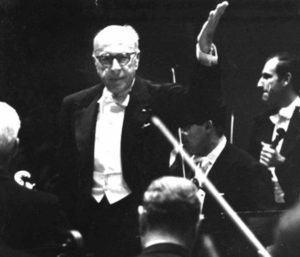In today’s Wall Street Journal “Sightings” column I look at the current rash of symphony-orchestra strikes, and offer a historical perspective. Here’s an excerpt.
* * *
 Two American orchestras, in Fort Worth, Texas, and Pittsburgh, are currently on strike, and a third, the Philadelphia Orchestra, recently settled an opening-night strike. Such conflicts are becoming common, and as usual, money is to blame. It’s the old, old story: Management says there’s no more cash in the till and proposes to cut salaries. The players reply that there are better ways to trim the budget. Result: Stalemate, followed by picket lines….
Two American orchestras, in Fort Worth, Texas, and Pittsburgh, are currently on strike, and a third, the Philadelphia Orchestra, recently settled an opening-night strike. Such conflicts are becoming common, and as usual, money is to blame. It’s the old, old story: Management says there’s no more cash in the till and proposes to cut salaries. The players reply that there are better ways to trim the budget. Result: Stalemate, followed by picket lines….
It’s worth remembering—yet hardly ever mentioned in news reports—that in the U.S., most orchestral musicians make a lot more money than they did only a couple of generations ago….
My quest for perspective began with “Tales From the Locker Room,” an oral history of the Cleveland Orchestra published in 2015. Lawrence Angell and Bernette Jaffe, the authors, interviewed Arnold Steinhardt, who played under George Szell in Cleveland before becoming the first violinist of the Guarneri Quartet in 1964. When he joined the orchestra in 1959, Mr. Steinhardt recalled, “Most of the orchestra, with families to feed, did what they could to make a living….Sam Salkin, first violin, tried to sell me a watch; Ed Matey, second violin, offered me mutual funds; Irv Nathanson, double bass, wondered if I needed instrument insurance; and Angie Angelucci, French horn, tried to sell me a Plymouth.”
 Mr. Steinhardt wasn’t exaggerating. Prior to 1968, membership in the Cleveland Orchestra was a part-time job. When he joined the orchestra, the regular season was just 30 weeks long, with lower pay for summer concerts. In 1952, the base salary was $3,240—$29,231 in today’s dollars. By 1967, it had only gone up to $11,700. (The current base salary is $120,000.) The U.S. median household income in 1967, by contrast, was $7,970. According to a 1952 survey, 60% of the players moonlighted in non-musical jobs…
Mr. Steinhardt wasn’t exaggerating. Prior to 1968, membership in the Cleveland Orchestra was a part-time job. When he joined the orchestra, the regular season was just 30 weeks long, with lower pay for summer concerts. In 1952, the base salary was $3,240—$29,231 in today’s dollars. By 1967, it had only gone up to $11,700. (The current base salary is $120,000.) The U.S. median household income in 1967, by contrast, was $7,970. According to a 1952 survey, 60% of the players moonlighted in non-musical jobs…
Yes, the Cleveland Orchestra was a regional ensemble notorious in the music business for its stingy salaries—but George Szell, who became its music director in 1947, somehow managed to turn it into one of the world’s finest orchestras anyway….
Should the members of the Cleveland Orchestra have been paid far more in Szell’s day? Obviously. Do they, and their colleagues in other American orchestras, deserve to be paid salaries in accord with their artistry, as well as with the years of painstaking effort that went into mastering their craft? Of course. I used to be a bass player, and nobody needs to tell me how hard orchestral musicians work. But lots of other people think they “deserve” to make higher salaries, often with good reason….
* * *
Read the whole thing here.
George Szell rehearses the Cleveland Orchestra in the first movement of Beethoven’s Fifth Symphony in 1966:

 •
• 